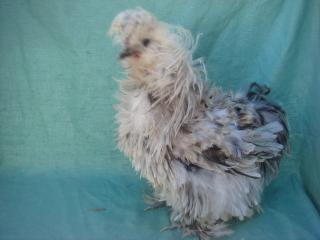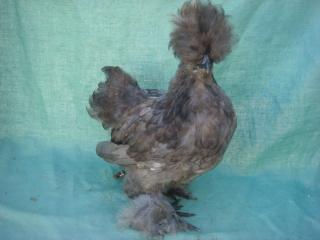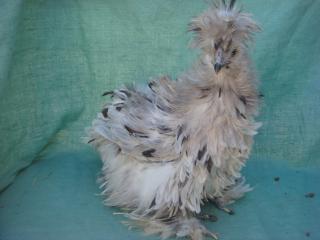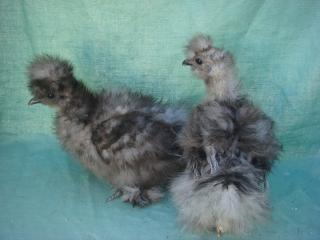Greetings All;
I have been breeding Sizzles for 5 generations. I am by no means an expert, either on chickens or on genetics but, I have some practical experience & because of the great people on the Sizzle list, Ive learned lots. I have tried to keep track of the information on BYC about Sizzles & realized that there is a lot of confusions so I hope by sharing some basic information it will help others.
Frizzle is a feather type & can be found in most breeds. Sizzle is a developing breed. The standard we are working with at this time are basically the Silkie standard but, with a change in feather type to hard frizzled and as a variety, smooth. That means, 5 toes, blue skin, crests, walnut or pea comb, turquoise ear lobe, compact body type, etc. We are still working out the fine points & will eventually write our own standard to include the changes we desire.
Sizzles are, in the original breeding, a cross of a Frizzled Cochin to a Silkie (matters not which parent was which) The chicks produced are referred to as F1 ie: first generation. . The cross produces 4 types of feathers - smooth regular, frizzled reg, silkie reg & frizzled silkie (Frilkie) You can breed opposites back to each other ie; smooth silkie to frizzled reg, frizzled silkie to smooth reg..etc. to produce the desired frizzled & smooth Sizzles. In the earlier generations it is not uncommon to see only 25% with frizzled feathers & that doesnt take into account getting the proper crests, toes, color or combs.
It is risky to breed a frizzle feathered bird to a frizzle feathered bird (no matter what breed) because you get what is called a frazzle which in more scientific terms is a double ff gene in both parents. This produces feathers that are brittle & tend to break off, leaving a bald bird & often times internal irregularities that can shorten the life span. So, that said, the general rule of thumb is to breed a frizzled coat to a smooth coat, preferable one with frizzle genetics. We (those folks on the Sizzle list) have decided to include smooth feathered sizzles as a variety of Sizzles for that very reason.
Following that rule of thumb, your next choice is to check you traits & breed for what you want ie; a light pigmented bird to a dark, straight comb to walnut, 4 toes to 5 etc. Choose your best stock & breed to reduce faults & increase desired results. It took me 5 generations to weed out 4 toed birds in favor of 5 toes & I'm still getting some straight combs and some light pigmentation but, ..it's a process and a very challenging & interesting one at that!
For the sake of simplicity we have taken to calling them Sizzle (with a capital S) for frizzled Sizzles & sizzle (with a lower case s) for smooth sizzles. Frilkie is a frizzled silkie. It just saves a lot of typing.
I have been breeding only back into my own lines, since I started out with a sizable gene pool. Ive been hatching over 200 chicks per year. My F5 generation produced about 30-35% birds that I considered progressed far enough to keep & I still have my share of faults to breed out. I'm taking a clue from some of the other successful breeders this year & breeding back to Silkie roos to strengthen my characteristics. The challenge there is then I increase the chance of getting Silkie feathers, which we don't want but, I feel my lines are fairly strong at this point & need the infusion of traits that I still need to improve.
So to answer some of the questions Ive been asked, I would avoid breeding back to Cochins if at all possible as you really only breed to them for the feathers & don't want the other traits. If you don't have a smooth sizzle roo to breed your frizzled Sizzle girls back to, try a Silkie roo. You'll get a higher % of silkie coats but, most of them will have the Sizzle genes also & you can breed them back to a hard coated Sizzle next year.
I hope this helps clarify some of the general questions out there. There is a lot more in depth information available that just takes some asking & digging to get to. If I can be of any assistance in that quest ...well, it helps me learn too!
Best of Luck!
SarahsSizzles

 Splash Sizzle Roo
Splash Sizzle Roo

 Smooth blue sizzle pullet
Smooth blue sizzle pullet

 Splash Sizzle pullet
Splash Sizzle pullet

 Blue Frilkies
Blue Frilkies
I have been breeding Sizzles for 5 generations. I am by no means an expert, either on chickens or on genetics but, I have some practical experience & because of the great people on the Sizzle list, Ive learned lots. I have tried to keep track of the information on BYC about Sizzles & realized that there is a lot of confusions so I hope by sharing some basic information it will help others.
Frizzle is a feather type & can be found in most breeds. Sizzle is a developing breed. The standard we are working with at this time are basically the Silkie standard but, with a change in feather type to hard frizzled and as a variety, smooth. That means, 5 toes, blue skin, crests, walnut or pea comb, turquoise ear lobe, compact body type, etc. We are still working out the fine points & will eventually write our own standard to include the changes we desire.
Sizzles are, in the original breeding, a cross of a Frizzled Cochin to a Silkie (matters not which parent was which) The chicks produced are referred to as F1 ie: first generation. . The cross produces 4 types of feathers - smooth regular, frizzled reg, silkie reg & frizzled silkie (Frilkie) You can breed opposites back to each other ie; smooth silkie to frizzled reg, frizzled silkie to smooth reg..etc. to produce the desired frizzled & smooth Sizzles. In the earlier generations it is not uncommon to see only 25% with frizzled feathers & that doesnt take into account getting the proper crests, toes, color or combs.
It is risky to breed a frizzle feathered bird to a frizzle feathered bird (no matter what breed) because you get what is called a frazzle which in more scientific terms is a double ff gene in both parents. This produces feathers that are brittle & tend to break off, leaving a bald bird & often times internal irregularities that can shorten the life span. So, that said, the general rule of thumb is to breed a frizzled coat to a smooth coat, preferable one with frizzle genetics. We (those folks on the Sizzle list) have decided to include smooth feathered sizzles as a variety of Sizzles for that very reason.
Following that rule of thumb, your next choice is to check you traits & breed for what you want ie; a light pigmented bird to a dark, straight comb to walnut, 4 toes to 5 etc. Choose your best stock & breed to reduce faults & increase desired results. It took me 5 generations to weed out 4 toed birds in favor of 5 toes & I'm still getting some straight combs and some light pigmentation but, ..it's a process and a very challenging & interesting one at that!
For the sake of simplicity we have taken to calling them Sizzle (with a capital S) for frizzled Sizzles & sizzle (with a lower case s) for smooth sizzles. Frilkie is a frizzled silkie. It just saves a lot of typing.
I have been breeding only back into my own lines, since I started out with a sizable gene pool. Ive been hatching over 200 chicks per year. My F5 generation produced about 30-35% birds that I considered progressed far enough to keep & I still have my share of faults to breed out. I'm taking a clue from some of the other successful breeders this year & breeding back to Silkie roos to strengthen my characteristics. The challenge there is then I increase the chance of getting Silkie feathers, which we don't want but, I feel my lines are fairly strong at this point & need the infusion of traits that I still need to improve.
So to answer some of the questions Ive been asked, I would avoid breeding back to Cochins if at all possible as you really only breed to them for the feathers & don't want the other traits. If you don't have a smooth sizzle roo to breed your frizzled Sizzle girls back to, try a Silkie roo. You'll get a higher % of silkie coats but, most of them will have the Sizzle genes also & you can breed them back to a hard coated Sizzle next year.
I hope this helps clarify some of the general questions out there. There is a lot more in depth information available that just takes some asking & digging to get to. If I can be of any assistance in that quest ...well, it helps me learn too!
Best of Luck!
SarahsSizzles




Last edited:





